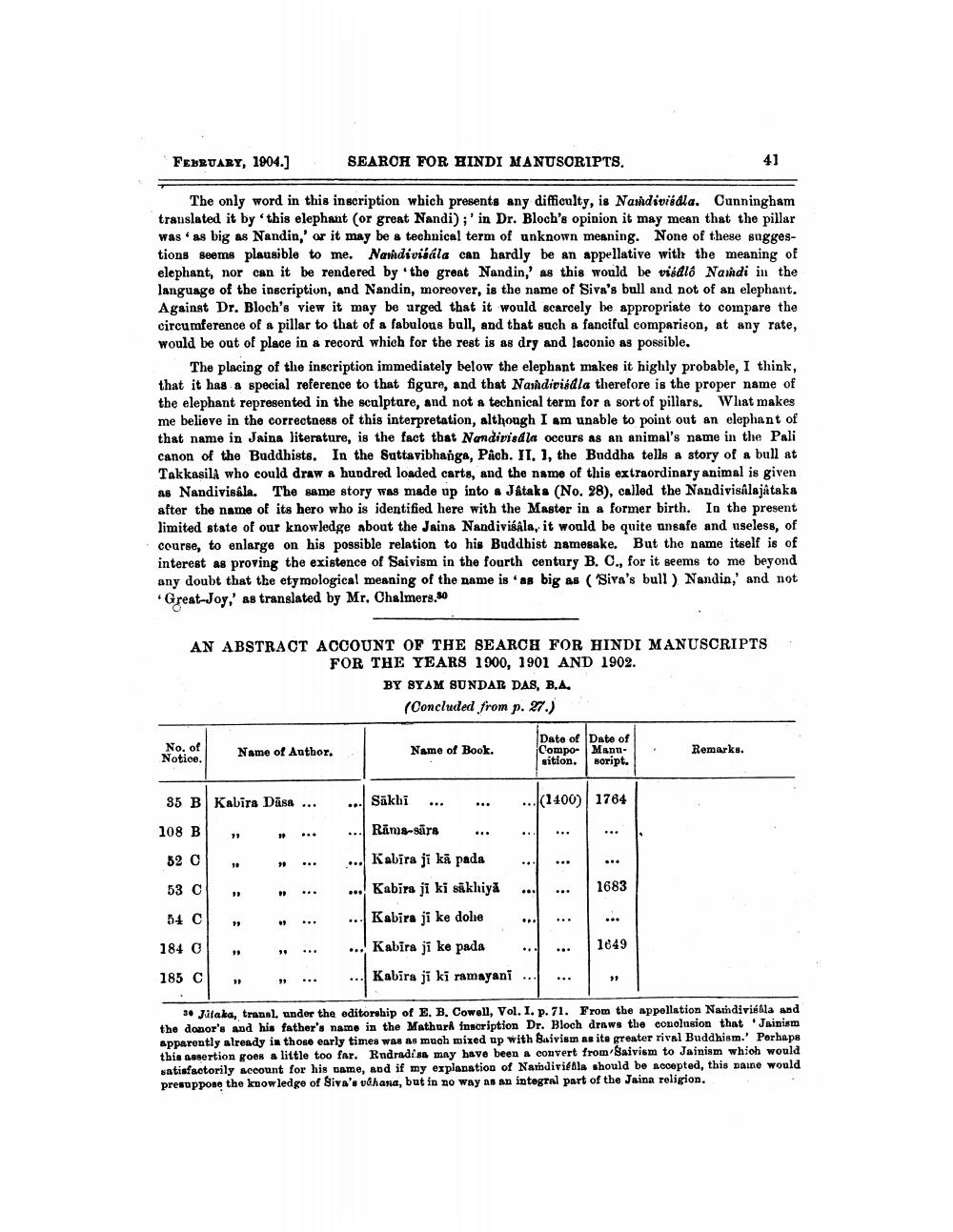________________
FEBRUARY, 1904.]
The only word in this inscription which presents any difficulty, is Namdiviidla. Cunningham translated it by this elephant (or great Nandi);' in Dr. Bloch's opinion it may mean that the pillar was as big as Nandin,' or it may be a technical term of unknown meaning. None of these suggestions seems plausible to me. Namdivisála can hardly be an appellative with the meaning of elephant, nor can it be rendered by the great Nandin,' as this would be viedlo Namdi in the language of the inscription, and Nandin, moreover, is the name of Siva's bull and not of an elephant. Against Dr. Bloch's view it may be urged that it would scarcely be appropriate to compare the circumference of a pillar to that of a fabulous bull, and that such a fanciful comparison, at any rate, would be out of place in a record which for the rest is as dry and laconic as possible.
The placing of the inscription immediately below the elephant makes it highly probable, I think, that it has a special reference to that figure, and that Nandiviidla therefore is the proper name of the elephant represented in the sculpture, and not a technical term for a sort of pillars. What makes me believe in the correctness of this interpretation, although I am unable to point out an elephant of that name in Jaina literature, is the fact that Nandivisala occurs as an animal's name in the Pali canon of the Buddhists. In the Suttavibhanga, Pâch. II. 1, the Buddha tells a story of a bull at Takkasila who could draw a hundred loaded carts, and the name of this extraordinary animal is given as Nandivisala. The same story was made up into a Jataka (No. 28), called the Nandivisâlajâtaka after the name of its hero who is identified here with the Master in a former birth. In the present limited state of our knowledge about the Jaina Nandivisâla, it would be quite unsafe and useless, of course, to enlarge on his possible relation to his Buddhist namesake. But the name itself is of interest as proving the existence of Saivism in the fourth century B. C., for it seems to me beyond any doubt that the etymological meaning of the name is as big as ('Siva's bull) Nandin,' and not 'Great-Joy,' as translated by Mr. Chalmers.30
4
No. of Notice.
AN ABSTRACT ACCOUNT OF THE SEARCH FOR HINDI MANUSCRIPTS FOR THE YEARS 1900, 1901 AND 1902.
BY SYAM SUNDAR DAS, B.A. (Concluded from p. 27.)
Name of Author.
35 B Kabira Dāsa....
108 B
52 C
53 C
54 C
184 C 185 C
29
10
19
SEARCH FOR HINDI MANUSCRIPTS.
19
39
Sākhi
Name of Book.
Rama-sura
Kabira ji kā pada Kabira ji ki sakhiya
Kabira ji ke dole
Kabira ji ke pada
Kabira ji ki ramayani
Date of Date of Compo- Manusition.
script.
(1400) 1764
...
***
1683
41
... 1649
33
Remarks.
30 Julaka, transl. under the editorship of E. B. Cowell, Vol. I. p. 71. From the appellation Namdiviéßla and the donor's and his father's name in the Mathura inscription Dr. Bloch draws the conclusion that Jainism apparently already in those early times was as much mixed up with Baivism as its greater rival Buddhism.' Perhaps this assertion goes a little too far. Rudradisa may have been a convert from Saivism to Jainism which would satisfactorily account for his name, and if my explanation of Namdivifila should be accepted, this name would presuppose the knowledge of Siva's vahana, but in no way as an integral part of the Jaina religion.




